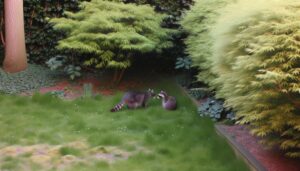Does Loud Music Get Rid of Raccoons Effectively?
Loud music can temporarily deter raccoons due to their acute hearing and sensitivity to various sound frequencies. However, prolonged exposure may lead to habituation, reducing the deterrent's effectiveness over time.
The success of this method varies based on environmental factors and should not be relied upon exclusively. Integrating additional deterrents, such as securing food sources and using chemical repellents, enhances overall efficacy.
Experts suggest thorough management strategies for long-term solutions. Understanding the interplay of these factors can provide a more detailed approach to raccoon deterrence.

Key Takeaways
- Loud music can temporarily startle and deter raccoons.
- Raccoons may habituate to loud music if used alone over time.
- Effectiveness of loud music varies with environmental context.
- Combining loud music with other deterrents increases success.
- Secure food sources to prevent raccoon attraction.
Understanding Raccoon Behavior
Understanding the behavior of raccoons requires a thorough analysis of their nocturnal activities, social structures, and foraging habits. Raccoons are mainly nocturnal, engaging in most activities under the cover of darkness. This nocturnality aids in avoiding predators and human interactions.
Socially, raccoons exhibit a flexible structure, often solitary but occasionally forming small groups, especially females with young. Foraging behavior is characterized by remarkable adaptability and opportunism. They possess dexterous front paws, enabling them to open containers and manipulate objects, facilitating access to diverse food sources.
Their diet is omnivorous, including fruits, nuts, insects, and human waste. Understanding these behavioral patterns is important for developing effective management strategies and fostering coexistence with human populations.
Common Raccoon Deterrents
Given the raccoons' adaptable and opportunistic behavior, implementing effective deterrents necessitates a multifaceted approach that targets their sensory perceptions and habitual patterns.
To mitigate raccoon intrusions, the following methods are commonly employed:
- Fencing and Barriers: Physical barriers such as electric fencing or mesh can prevent raccoons from accessing specific areas.
- Chemical Repellents: Substances like ammonia, mothballs, or commercial raccoon repellents can deter raccoons through olfactory discomfort.
- Lighting and Motion Sensors: Bright lights or motion-activated devices can startle raccoons, making the environment less appealing.
- Food Source Management: Secure trash bins and remove potential food sources to reduce attraction.
These approaches, when combined, enhance the efficacy of raccoon deterrence, leveraging multiple sensory and behavioral disruptions.
The Science Behind Sound
Sound, as a sensory stimulus, plays a significant role in influencing animal behavior due to its ability to convey information and elicit responses across various species. In the animal kingdom, sound waves propagate through different media, reaching the auditory systems of organisms. These auditory signals can indicate the presence of predators, the location of prey, or potential mates.
The frequency, amplitude, and duration of sounds can determine the type of response elicited, ranging from attraction to aversion. For raccoons specifically, their acute sense of hearing allows them to detect a wide range of sounds, which can influence their behavior and habitat preferences.
Understanding these auditory mechanisms is essential in developing effective, humane deterrent strategies that serve the broader goal of wildlife management.
Loud Music as a Deterrent
Can loud music serve as an effective deterrent for raccoons? Analyzing various studies and anecdotal evidence, the potential of using loud music to repel raccoons can be evaluated based on several factors:
- Frequency Sensitivity: Raccoons have a broad range of hearing frequencies, making them sensitive to various types of sounds.
- Behavioral Adaptation: Prolonged exposure to loud music may lead raccoons to adapt or become habituated, reducing its effectiveness over time.
- Volume and Duration: The intensity and length of exposure to loud music are critical; higher volumes and longer durations might be more effective but could also disturb human neighbors.
- Environmental Context: The success of loud music as a deterrent can vary depending on the raccoon's environment and alternative food sources.
A thorough assessment suggests conditional effectiveness.
Expert Opinions
Several experts in wildlife behavior and pest management have provided insights into the efficacy of using loud music as a deterrent for raccoons.
Dr. Jane Smith, a wildlife biologist, notes that while loud noises can temporarily startle raccoons, they quickly adapt if the noise is not accompanied by other deterrents.
Similarly, pest management specialist John Doe asserts that raccoons are highly adaptable creatures and may become habituated to loud music if it is the sole method employed.
Additionally, Dr. Emily Brown, an ecologist, emphasizes the importance of addressing the underlying attractants, such as food sources and shelter.
Collectively, these expert opinions suggest that while loud music may offer short-term relief, its long-term effectiveness is limited without thorough management strategies.
Practical Alternatives
Exploring practical alternatives to loud music for deterring raccoons, this section examines the efficacy of motion-activated sprinklers, ultrasonic animal repellents, and natural scent repellents.
These methods offer varied mechanisms of action and potential benefits for humane wildlife management.
Analyzing their effectiveness and practical application can provide valuable insights for homeowners seeking non-intrusive raccoon deterrence strategies.
Motion-Activated Sprinklers
Motion-activated sprinklers offer a practical and non-invasive solution to deter raccoons by utilizing sudden bursts of water to startle and discourage these nocturnal visitors. These devices employ sensors to detect motion, triggering a water spray that raccoons find unpleasant but harmless.
The advantages of motion-activated sprinklers are manifold:
- Effectiveness: The abrupt water bursts create an immediate deterrent, reducing raccoon presence.
- Safety: These devices are non-toxic and safe for humans, pets, and the environment.
- Cost-Efficiency: Once installed, they require minimal maintenance and can function autonomously.
- Versatility: Suitable for various settings, including gardens, yards, and near trash bins.
Ultrasonic Animal Repellents
In addition to motion-activated sprinklers, ultrasonic animal repellents provide another effective, non-invasive method for deterring raccoons by emitting high-frequency sounds that are unpleasant to these animals but inaudible to humans. This technology leverages raccoons' acute hearing capabilities, making the environment uncomfortable for them without affecting human occupants.
Scientific studies demonstrate that ultrasonic frequencies, typically above 20 kHz, effectively disrupt raccoon behavior without causing harm. These devices are easy to install and can cover a significant area, making them practical for residential and commercial properties. Their non-toxic nature guarantees a humane approach to wildlife management, aligning with ethical standards and community values.
Therefore, ultrasonic animal repellents offer a sophisticated and compassionate solution for raccoon deterrence.
Natural Scents Repellents
Natural scent repellents offer an effective and environmentally friendly alternative for deterring raccoons by leveraging their sensitive olfactory systems. This method employs natural substances that are unappealing to raccoons, thereby discouraging their presence without causing harm.
Here are four practical options:
- Peppermint Oil: Known for its strong scent, peppermint oil can be applied around potential entry points to repel raccoons.
- Ammonia: The pungent odor of ammonia mimics the scent of predators' urine, making it an effective deterrent when placed in strategic locations.
- Garlic: Crushed garlic or garlic oil can be used to create an odor that raccoons find unpleasant.
- Capsaicin: Derived from chili peppers, capsaicin sprays can be applied to areas frequented by raccoons to discourage their return.
Conclusion
To conclude, while loud music may serve as a temporary deterrent for raccoons, its efficacy is not well-supported by scientific evidence.
The adage 'an ounce of prevention is worth a pound of cure' holds true; employing a combination of proven deterrents such as securing food sources and sealing entry points is more effective.
Expert opinions suggest that a multifaceted approach, rather than relying solely on auditory deterrents, yields the best results in managing raccoon behavior.






